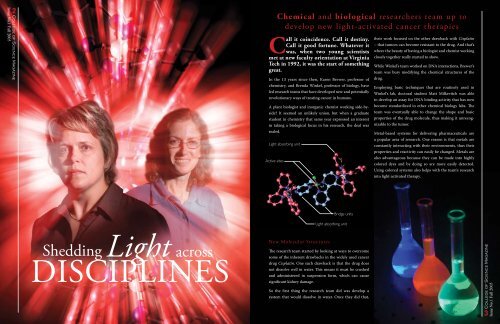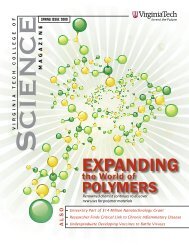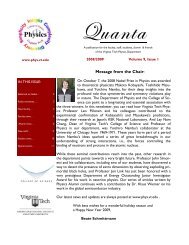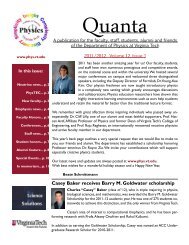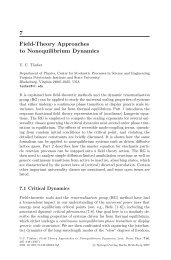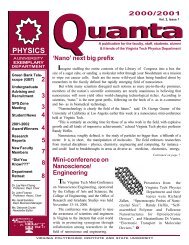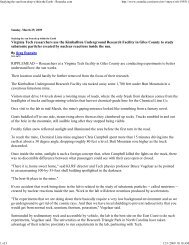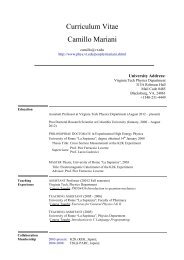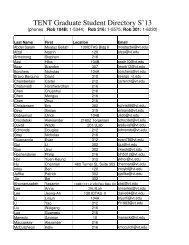College of Science Magazine, Fall 2005 - Physics - Virginia Tech
College of Science Magazine, Fall 2005 - Physics - Virginia Tech
College of Science Magazine, Fall 2005 - Physics - Virginia Tech
You also want an ePaper? Increase the reach of your titles
YUMPU automatically turns print PDFs into web optimized ePapers that Google loves.
<strong>College</strong> <strong>of</strong> <strong>Science</strong> <strong>Magazine</strong><br />
Issue No.1 <strong>Fall</strong> <strong>2005</strong><br />
Call it coincidence. Call it destiny.<br />
Call it good fortune. Whatever it<br />
was, when two young scientists<br />
met at new faculty orientation at <strong>Virginia</strong><br />
<strong>Tech</strong> in 1992, it was the start <strong>of</strong> something<br />
great.<br />
In the 13 years since then, Karen Brewer, pr<strong>of</strong>essor <strong>of</strong><br />
chemistry, and Brenda Winkel, pr<strong>of</strong>essor <strong>of</strong> biology, have<br />
led research teams that have developed new and potentially<br />
revolutionary ways <strong>of</strong> treating cancer in humans.<br />
A plant biologist and inorganic chemist working side-byside?<br />
It seemed an unlikely union, but when a graduate<br />
student in chemistry that same year expressed an interest<br />
in taking a biological focus in his research, the deal was<br />
sealed.<br />
Chemical and biological researchers team up to<br />
develop new light-activated cancer therapies<br />
Light absorbing unit<br />
Active sites<br />
their work focused on the other drawback with Cisplatin<br />
– that tumors can become resistant to the drug. And that’s<br />
where the beauty <strong>of</strong> having a biologist and chemist working<br />
closely together really started to show.<br />
While Winkel’s team worked on DNA interactions, Brewer’s<br />
team was busy modifying the chemical structures <strong>of</strong> the<br />
drug.<br />
Employing basic techniques that are routinely used in<br />
Winkel’s lab, doctoral student Matt Milkevitch was able<br />
to develop an assay for DNA binding activity that has now<br />
become standardized in other chemical biology labs. The<br />
team was eventually able to change the shape and basic<br />
properties <strong>of</strong> the drug molecule, thus making it unrecognizable<br />
to the tumor.<br />
Metal-based systems for delivering pharmaceuticals are<br />
a popular area <strong>of</strong> research. One reason is that metals are<br />
constantly interacting with their environments, thus their<br />
properties and reactivity can easily be changed. Metals are<br />
also advantageous because they can be made into highly<br />
colored dyes and by doing so are more easily detected.<br />
Using colored systems also helps with the team’s research<br />
into light-activated therapy.<br />
Bridge units<br />
Light absorbing unit<br />
Light<br />
Shedding across<br />
Disciplines<br />
New Molecular Structures<br />
The research team started by looking at ways to overcome<br />
some <strong>of</strong> the inherent drawbacks in the widely used cancer<br />
drug Cisplatin. One such drawback is that the drug does<br />
not dissolve well in water. This means it must be crushed<br />
and administered in suspension form, which can cause<br />
significant kidney damage.<br />
So the first thing the research team did was develop a<br />
system that would dissolve in water. Once they did that,<br />
<strong>College</strong> <strong>of</strong> <strong>Science</strong> <strong>Magazine</strong><br />
Issue No.1 <strong>Fall</strong> <strong>2005</strong>


